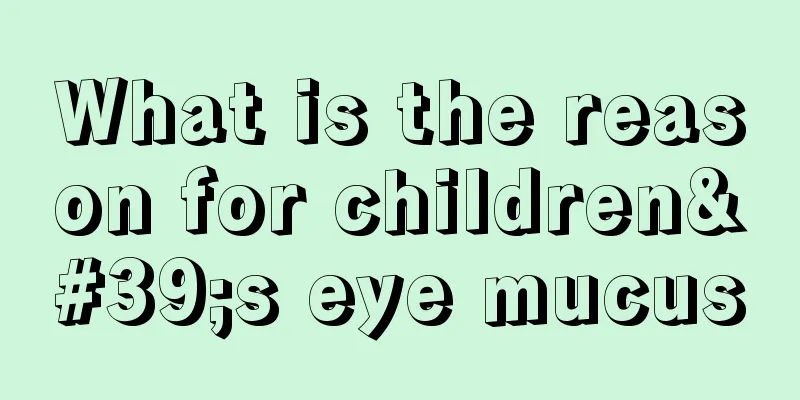Will roseola infantum appear on the face?

|
Roseola infantum is a disease that children often suffer from. However, since each person's physical condition is different, the symptoms may be different when the rash appears. Generally, when roseola infantum is healing, many rashes will appear on the baby's body, but these rashes will gradually disappear as the disease recovers. Rashes on the baby's skin will affect the baby's physical health. Will roseola infantum appear on the face? Roseola infantum may appear on the face. Emergency fever in infants and young children usually lasts about 3 days, and a rash will appear all over the body within two days after the fever subsides. It is normal for some children to have a rash on their face, and for many children to have a rash in their hair. This is all normal and shows that the baby has successfully resisted the virus and is detoxifying. Roseola infantum, also known as infantile roseola, is an acute rash infectious disease common in infants and young children caused by infection with human herpes virus types 6 and 7. The clinical features are high fever for 3 to 4 days, followed by a sudden decrease in fever and the appearance of a rash, and the condition recovers quickly. After the baby comes to the doctor, he will feel itchy, which will make him particularly irritable. The mother should try to divert the baby's attention and not let him scratch to avoid infection. At the same time, the mother can give the baby a bath and keep the skin dry and clean, which can appropriately reduce the degree of itching. At the same time, try not to let the baby be exposed to cold wind. Prevention of Roseola Infantitis: 1. Keep the indoor air circulating, pay attention to the temperature and humidity, and avoid overcooling or overheating. 2. The diet should be easily digestible food, rich in vitamins, calories and appropriate amount of protein. Increase the amount of water intake appropriately and avoid eating raw, cold and greasy food. 3. General patients do not need to be isolated. In collective children's institutions, susceptible children who have been in contact with patients should be closely observed for 10 days. If they have a fever, they need to be temporarily isolated and treated. 4. Pay attention to environmental hygiene and children’s personal hygiene. How to check for roseola infantum: 1. Routine blood test. On the first 1-2 days after the onset of the disease, the white blood cell count may increase, but it will decrease significantly after the rash occurs, while the lymphocyte count will increase, reaching a maximum of over 90%. 2. Virus isolation. Virus isolation is the diagnostic method for HHV-6 and 7 infections. HHV-6 and 7 can proliferate in fresh cord blood mononuclear cells or adult peripheral blood mononuclear cells. However, substances such as phytohemagglutinin (PHA), IL-2, and dexamethasone need to be added to the culture medium. The infected cells show pathological changes in about 7 days, and the cells are pleomorphic, with karyopyknosis and multinucleated cells. Infected cells can continue to survive for 7 days after developing pathological changes, while uninfected cells die within 7 days of culture. Since virus isolation and culture is time-consuming and not suitable for early diagnosis, it is generally only used in laboratory research. 3. Detection of viral antigens. Viral antigen testing is suitable for early diagnosis, but viremia lasts for a short time, making it difficult to collect specimens in a timely manner. Immunohistochemistry is currently widely used to detect viral antigens in cells and tissues. A positive antigen result can be used as a basis for diagnosis. 4. Viral nucleic acid testing. HHV-6 and 7 DNA can be detected by nucleic acid hybridization and PCR methods. Because HHV-6 and 7 both have latent infections, sometimes detecting viral DNA does not determine whether it is in a latent or activated state. Quantitative and semi-quantitative PCR can be used to measure the amount of DNA to determine whether there is active infection. High concentrations of viral DNA indicate the presence of active infection. |
<<: My child always feels something in his throat
>>: What should I do if I have received intravenous drip for roseola infantum?
Recommend
What is the reason for the baby's fever of 37.4
During the baby's growth process, some unexpe...
The fastest way to treat cough in babies
Nowadays, the incidence of severe cough in babies...
Diet therapy for bronchial asthma in children, seven foods are worth recommending
If a disease like bronchial asthma occurs in a ch...
What should children with weak spleen and stomach eat?
Spleen and stomach deficiency is no longer a stra...
Dexamethasone dosage for children
Many people have experienced allergies. Allergies...
What should I do if my child’s neck hurts when twisting?
In daily life and work, certain bad habits can ca...
What to do if a 6-year-old child has a hunchback
For children, health is everything. Only a health...
How to deal with a baby's fever of 40.5
It is rare for a baby to have a fever of 40.5 deg...
What are the symptoms of otitis in children?
Children with mumps are often called "big mo...
What should I do if my 3-year-old baby has stomachache?
What is the reason why babies often complain of s...
Why is the area around the belly button cold?
In life, some people may feel cold around their b...
Newborn baby eczema on head
Eczema is a very common disease, especially for n...
What’s wrong with my baby’s scrotum swelling?
Scrotal swelling in babies is a disease that many...
How to treat gray hair in middle school students
We all know that middle school students are under...
Is it normal for a baby girl to have leucorrhea? How to provide care
Nowadays, many newborn baby girls occasionally ha...









